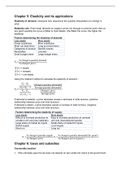Samenvatting
Summary Economics (Modern Prinicples of Economics)
- Instelling
- Universiteit Van Amsterdam (UvA)
Elaborate summary including the chapters of the midterm and endterm of economic, with the book Modern Principles of Economics. Chapters included: chapters 5, 6, 8, 9, 10, 13, 15-18, 22, 24 - 26, 28, 30 - 36, 38
[Meer zien]





